Need a little hand setting up your splitboard? I’m psyched for you. once this sucker is fully-operational, you’ll be chasing down mountains for years to come. There’s no better way to get after the choicest lines and the deepest powder. So let’s dive into this, the ultimate splitboard setup guide.
BTW, if you’re in Denver, just shoot me an email and I’ll come help you out myself. I also offer splitboard and snowboard tuning with a super-quick turnaround and a very convenient scheduling system.
Hopefully you’ve already got your deck picked out, maybe even a binding system. If not, well I’m working on more articles to help with all of those decisions. And, like I said, feel free to send an email to [email protected] if you want some custom assistance on the double.
But I’m sure you’re perfectly capable of a splitboard setup on your own, wherever you are. It’s not too tough, and you’ve managed to find this totally thorough explanation here, so let’s get that rig ready for the deepest and steepest.
I also put together a video covering the full installation. It’s helpful to run through the video in conjunction with this post in order to fit the visual with the conceptual.
Materials Required for Setting up a Splitboard
First let’s make sure we’ve got all of the proper equipment together. and this is where we’ll already encounter our first wrench in the works. There are several basic designs of splitboard mount, and your mount will determine what materials you need and how best to approach this whole deal. No problem though, we’ll walk you through it, with pics and carefully worded messages of inspiration.
Tools
A big ass phillips head screwdriver. You’re looking for a #3 phillips, that should be the best size for most snowboard bindings. Splitboard or snowboard, doesn’t matter, this tool is pretty much all you need to assemble a board. It is your snowboard-building excalibur.
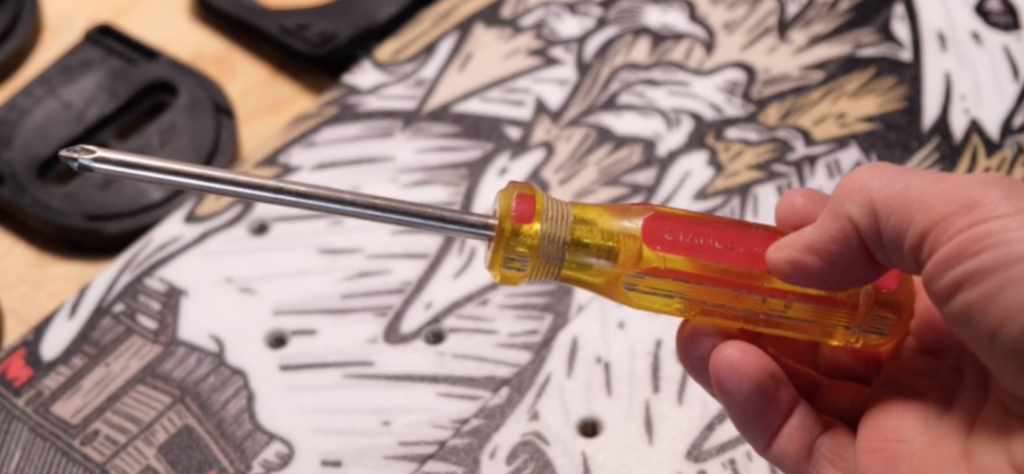
Components
Splitboard
You need the deck. That’s not exactly optional. Your key concern to begin with is sizing. You want a length and width that will serve you well in the backcountry. As a newcomer, this will largely be determined by size and weight.
Just nailing down the length and width you’re looking for will eliminate a ton of possibilities. You don’t want to ride too far outside of your optimal sizing or you run into issues. Your ride may sink a little too readily or it may be stiffer than is really comfortable. Or, if you have monster feet, you could end up dragging toes when you roll into a good turn.
If you’ve been resort riding for a long time, you may have developed some idea of what you like to ride. But that may change a little in the backcountry where you’re not going to find long the groomers or the rails and kickers you may be accustomed to. Splitboards will typically be a little stiffer and longer than your average resort board because of this difference in terrain. This goes double if you’re into park riding where you probably want a short, snappy deck.
While not exactly recommended for newcomers, you can build a splitboard from an existing snowboard. This may be surprising, but you can literally just saw an old deck in half and get a kit from voilé with all of the hardware that you need to snap it back together.
Bindings
Bindings can get easily as complicated if not more complicated than the deck. I’ve got a full post that covers the ins and outs if this brief rundown isn’t providing all of the answers you need.
Over the years, several systems have evolved for splitboard bindings. The classic system come from voilé and the majority of splitboard bindings will simply provide an interface to this system. But companies like Karakoram have evolved their own systems.
If you’re in a money-saving mode, you can get a voilé kit that will allow you to bolt your resort bindings onto some rails that will mount to your splitboard. You can save a couple hundred bucks pretty easily here, but it’s a little annoying that every time you ride at the resort you’re going to have to setup your deck. And splitboard-specific bindings do tend to be lighter and just a little more comfortable to ride.
Splitboard Hardware
A high-level overview of all of the parts of splitboard bindings is kinda helpful. Clips will often come pre-mounted on your deck. But you may have to mount them yourself. And you will most likely need to mount your own heel and toe hardware and some kind of puck system to connect your bindings to.
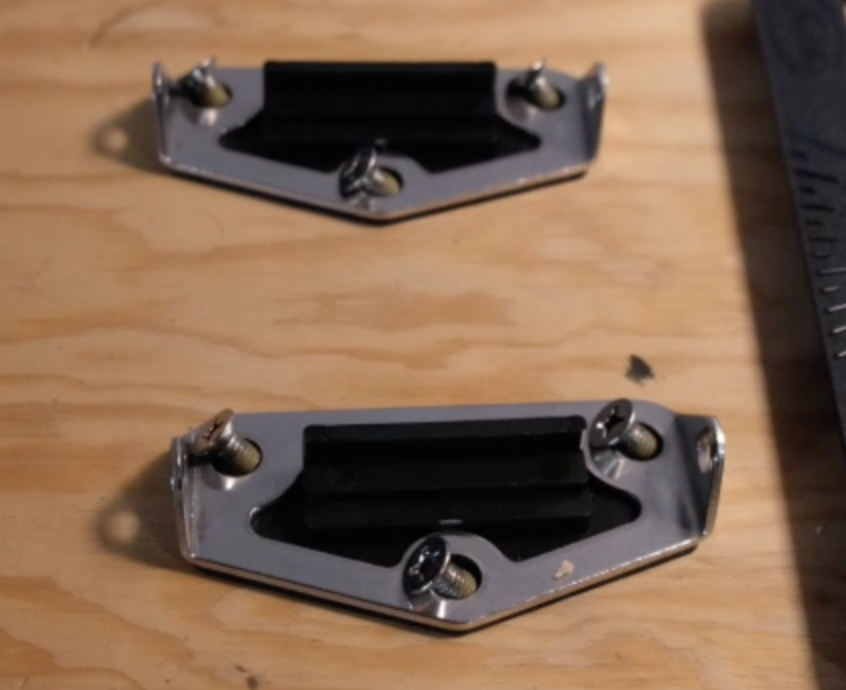
Toe Hardware
In whatever kit you have, you should find these 2 plates, with 3 mounting holes each. Near the middle of your split deck, but towards the nose end, you should find the pattern that matches these toe plates.
These toe clips are mounting points for the toe of your bindings. They form a pivot, so that you can lift your heels and still stay stuck firmly to the board. Often times this is as simple as a steel peg that slides through a hole or tube and locks your toe in place.
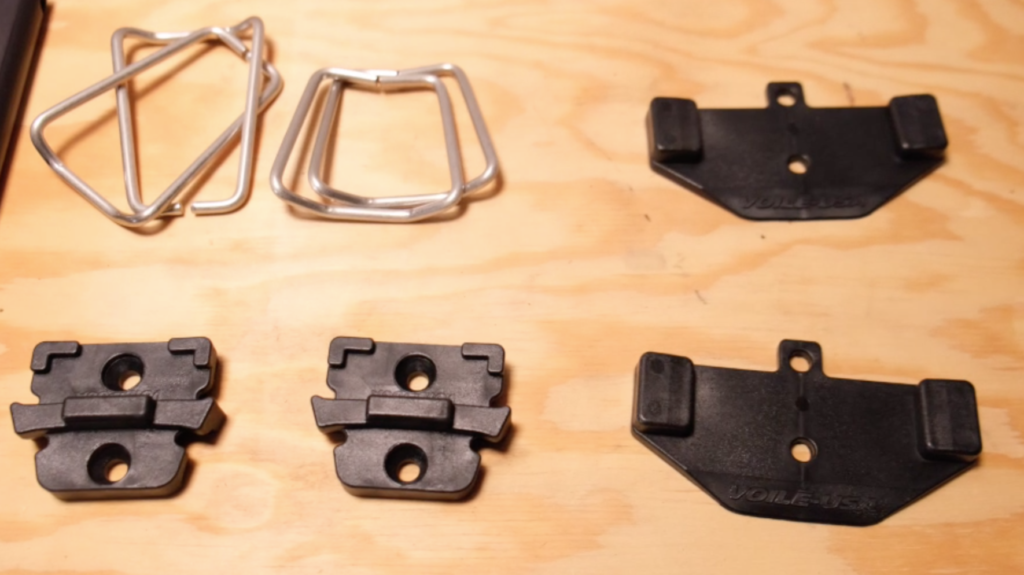
Heel Hardware
Now you have your heel plates. This stuff comes together like Voltron to form a base for your heels while you’re climbing snowy mountains.
The standard mode is just a platform to keep your heels level with your toes so you don’t put stress on the toe hinges.
But those steel wires in the upper left are your climbing rails. They fit into the plastic guides just below them and screw down over the base plates pictured on the right-hand side of the image. Once configured, your climbing rails can easily flip up to provide an elevated platform for your heels. If you’ve never experienced this feature, it seems weird, but as soon as you get on an ascent and pop up those climbing rails, it’s painfully obvious how valuable they are.

The Puck System
For downhills, you need to pop off those bindings and reaffix them in a snowboard stance. Most often this is done through a series of plastic fixtures that are often called ‘pucks’, for obvious reasons. I’m referencing the Voilé puck system here, but a lot of this will apply to other systems readily.
These pucks are screwed to the main mounting holes on your deck in your preferred riding configuration. Your bindings will then slide over these pucks and lock in place, probably using the same system that locks your toes in ascent-mode.
Skins
Splitboards, as you may have noticed, are designed to slide downhill. If you want to try and go uphill, you’re going to need some climbing skins. These are strips of fabric that adhere to the bottom of your splitboard. They’re designed to allow your board to slide forward, but grip a lot more actively than your board wax, especially when moving backwards.
This is one of the weirdest concepts to grasp about splitboarding if you’ve never had any exposure to ski touring. For a full rundown including some history and guidance in finding and setting up your first pair of skins, click on over here.
Procedure for Setting up a Splitboard
Now, let’s cover the down and dirty of actually fitting all of this hardware to your splitboard deck. Like I’ve mentioned, you can always turn to the video. It’s pretty helpful to see all of this stuff in action. But a quick read through can also be clutch in getting your head wrapped around the process here.
You probably have some sweet instructions to read for your bindings and maybe also for your hardware. They may be presented in any of several languages. Obviously, read those instructions in addition to this, but the general concepts here tend to stay fairly similar across designs. This means that even if your equipment doesn’t look exactly like mine, it’s probably still fairly applicable.
For my first rig I got the Voilé rail system and set it up with my resort bindings. This can be a little annoying to deal with. You’ll need to swap your bindings every time you switch from backcountry to resort riding. Plus, these bindings tend to ride higher than the split-specific models which can approach the comfort of a resort board. But this is still probably going to be the cheapest and most effective option for your first split deck.

1. Install the Toe Clips
We’ll start with mounting the ascent hardware to the middle of the length of the deck. You should see 2 distinct bolt patterns here on each half of your deck. In the middle here, there’s a 3-hole pattern towards the nose-end and a 2-hole pattern towards the tail-end.
Find the toe clips. Those are the plates that match up with that 3-hole pattern. Find the 3 corresponding screw. Make sure they’re coated with a little thread seal (they should come like this). Screw the toe plates down tight. Not too tight, just hand tight. Repeat on the opposite side of the split.
2. Install the Heel Platforms
The heels can be a little more complicated. You’re usually going to have climbing wires to consider here. The design of this part of your gear can vary a lot, so reference the guide or instructions specific to your equipment. Feel free to reach out if you get confused, I can usually walk you through a specific setup.
With the Voilé system, you have 4 pieces. There are 2 climbing wires to run at two different settings. They fit into a plastic bracket with channels in it that allows them to be flipped up and locked in place.
The two climbing rails are slightly different. On is longer and more narrow. The other is shorter and wider. They both have gaps at one end so they can be stretched opened. The opposite end is curved making for a more stable support platform for your heel.
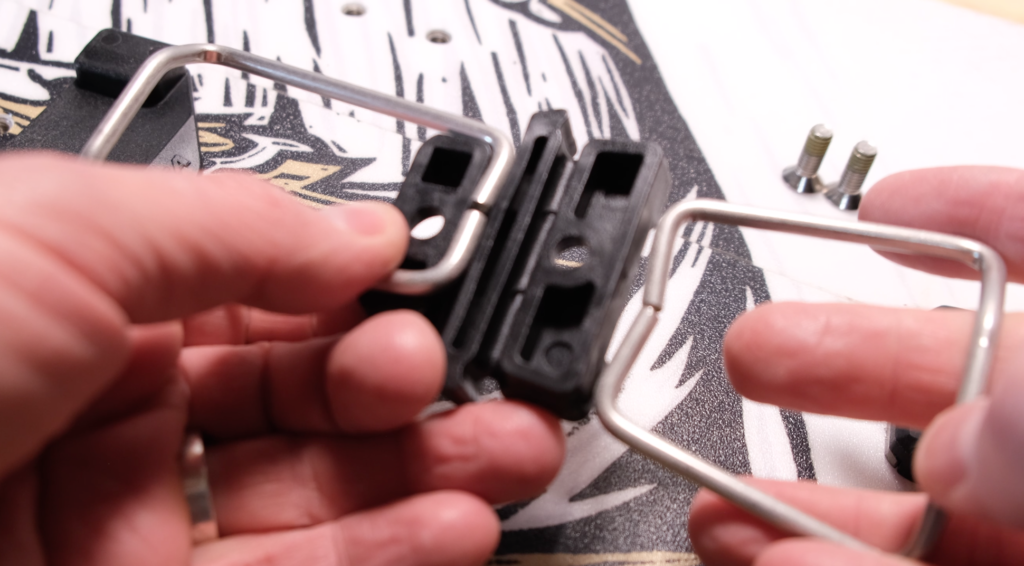
You’ll need to pop the gapped side of the climbing rails into the channels of the plastic guide. This plastic guide has 2 channels of 2 different lengths. The climbing rails need to be stretched apart and pressed into the correct channel, but there’s an important detail here…
Make sure that, when this assembly is screwed down, the curved portion of both rails should raise off of the deck.
It takes a little effort to stretch these rails and press them into the channels. You can kinda hook one edge of a rail around the base and pull the other side into place, but it takes trying.
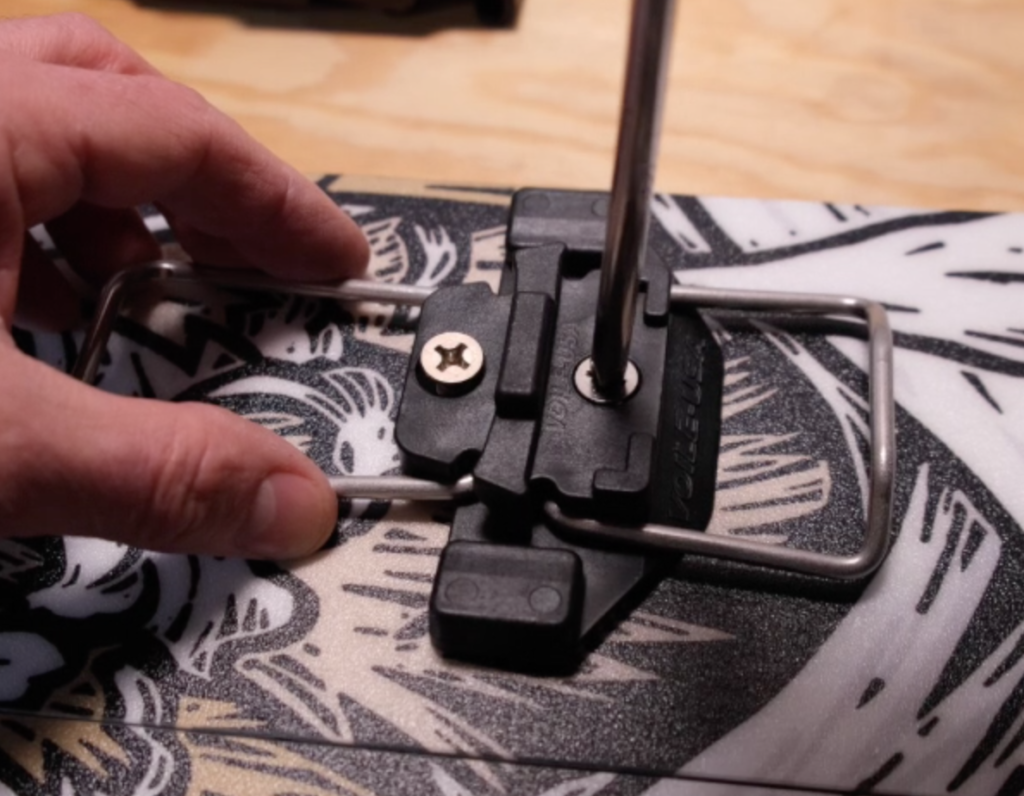
Once you get your climbing rails snapped into place, that bracket then screws down over the heel plate. Two screws mount through the climbing rail assembly, then through the heal plate, and into the 2 mounting holes parallel with the split deck.
Reference available diagrams to make sure that everything is oriented as intended. The wider rail should be on the narrower side of the heel plate and point towards the tail end of the board. Make sure the wires flip up and down and are properly seated. Remember, just hand tight.

3. Install the Pucks
You should have 2 different types of pucks. Both will often have A and B markings that signal the alignment of the puck perpendicular to the length of your deck. One type of puck will feature 2 parallel channels. The other will feature just one channel. The pucks fit into 4 guides shaped like a basketball key. These are all identical.
The single-channel puck is the heel-side puck. Note that the channel is slightly closer to the A side of the puck. Depending on your foot size in relation to the width of your board, you may want to move your heel a little forward or a little backward on your deck to find the right balance. If you want your heel closer to the heel side of your deck, install with the A side towards the heel side. And vice versa if you want your foot moved forward slightly.
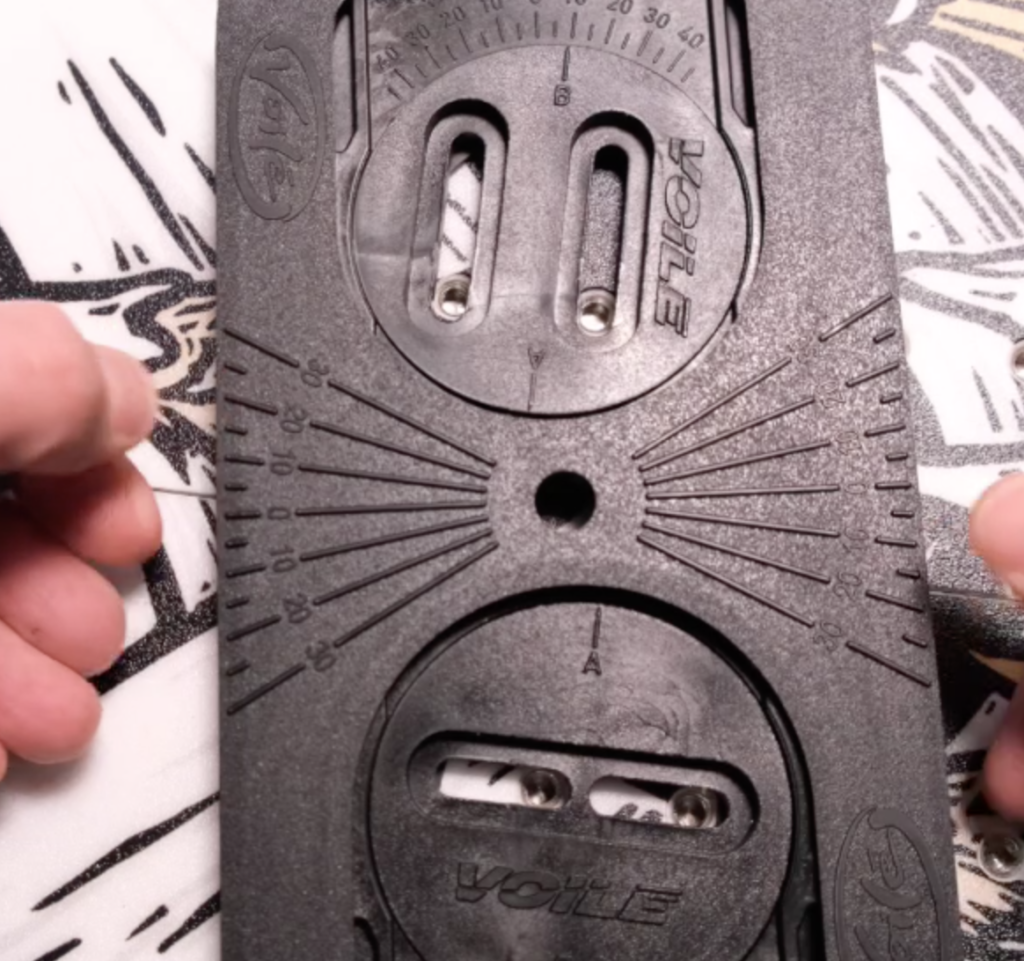
You’re going to need those positioning guides that came with your binding system. In your chosen configuration, nest the pucks in those basketball key shaped angle mounts and fit them into that plastic guide.
I like to start by setting my angles. I try to match my resort deck alignment in general, but I reduce the angle of my tail foot because I do less goofy riding in the backcountry.
With this alignment rig, to shift your toe outward, you rotate the heel and tow pucks to the right in equal amounts. However, you need to get your pucks to fit neatly over the screw patterns on your deck, so you may need to play around with the angles a little.
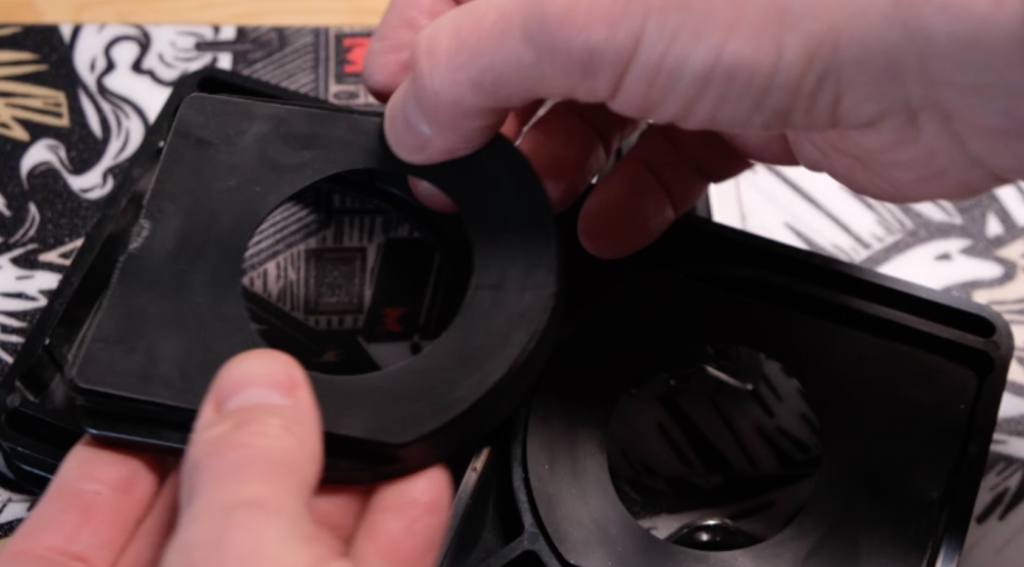
Once you get the pucks at a comfortable angle, place the gaskets on the back. These gaskets don’t really fit snug. I used a little super glue to hold them in place and keep them from shifting when I flip the whole thing over onto the deck.
Now you can slide your alignment into position where you want to stand on your deck. Check your stance width and your positioning. Jump in the air and land in a comfortable riding stance. Mark the positions of your feet and compare it to the foot positioning on your deck.

When you’re satisfied with your alignment and you have your pucks positioned neatly over the mounting holes so that you can see the entirety of the 4 corresponding mounting holes through the puck channels, insert the bolts and gently but firmly tighten them down.
Put a little extra care into tightening down the pucks here. You want these screws only hand-tight, but very firmly hand-tight. I push firmly on the back of the screwdriver and slowly rotate it under pressure to get a nice, tight clamp on those pucks. You should check them for tightness frequently as well to avoid binding malfunctions in the backcountry.
You can now remove that alignment bracket. It should just slide off the top.
A general exception to this whole mess is if you’re deck is setup with a channel-mount system. In this case, mounting the pucks is super straightforward and you don’t need to worry as much about the adjustments. You just set them up and lock them down.
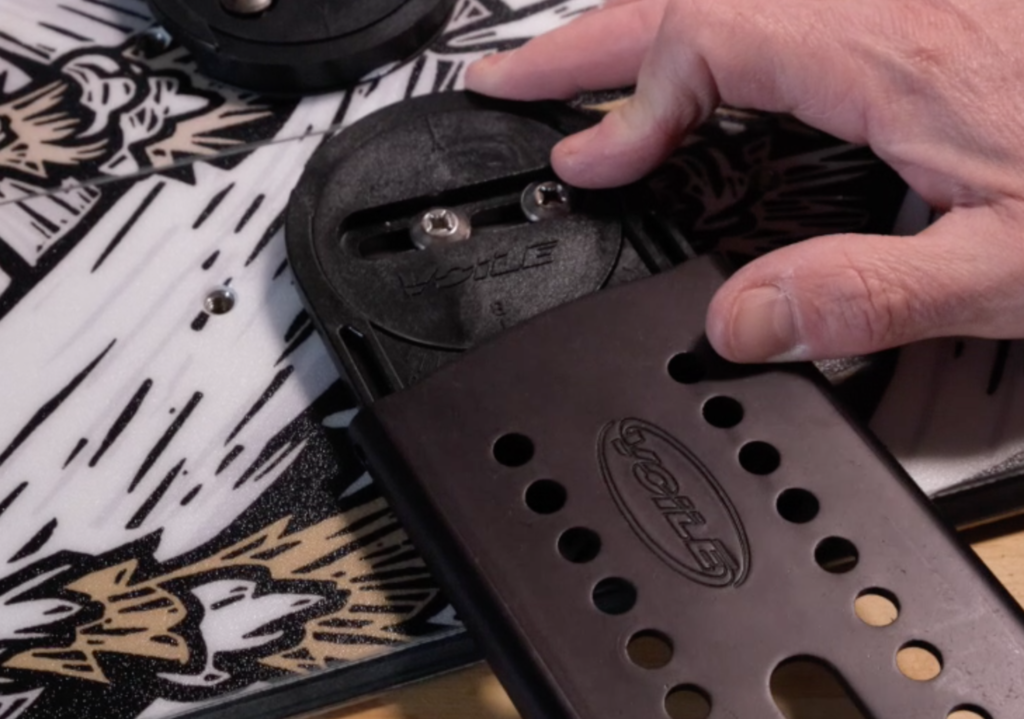
Either way, this is a good time to try sliding your binding rails onto your puck and make sure everything is working correctly. It should take some effort, but the rails should slide on smoothly and lock into place with the tab at the heel-side.
This will be easier when you get your bindings mounted and you can get more leverage.
4. Mount your Regular Bindings to the Voilé Rail
If you’re using split-specific bindings, you can skip this step.

But if you’re using the Voilé system to run regular bindings on your splitboard setup, you will need to connect the rails to your bindings.
First, you need to determine where you want your feet positioned. With one of the rails mounted on your pucks and the heel tab firmly locked up against your puck on the heel side, position your corresponding binding over the rail. Set your bindings in the 0° position.
You’re just setting the front-back positioning of your foot here. You don’t want your toe or heel hanging too far out over your deck, and you want to be balanced effectively over the board. When you ‘re happy with your placement, drop the mounting bolts for your bindings into the center of your bolt patterns and into the closest holes on the rails.
Now try to slide the rails off of the pucks without losing those bolt holes.

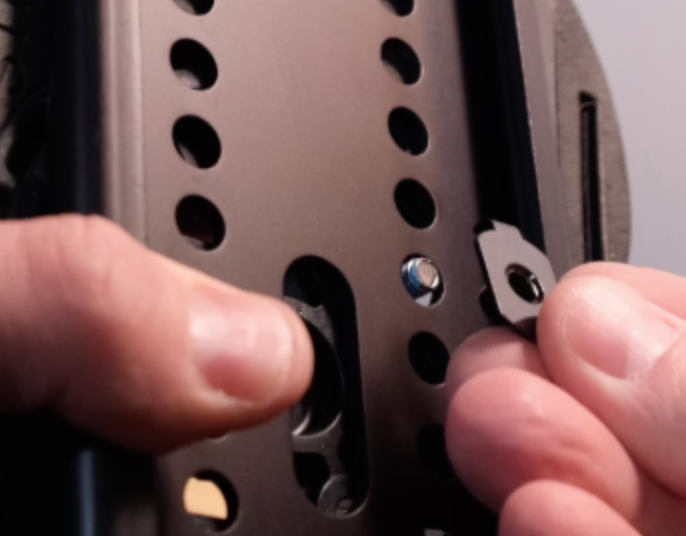
There are these little mounting plates in your kit that your binding mounting bolts are meant to screw into.
Place these into the underside of the corresponding holes with the little tabs nested into one of the nearby holes. The tabs keep these plates from rotating when you tighten them down. Use little pieces of electrical tape to hold these in position while you mount your bindings.
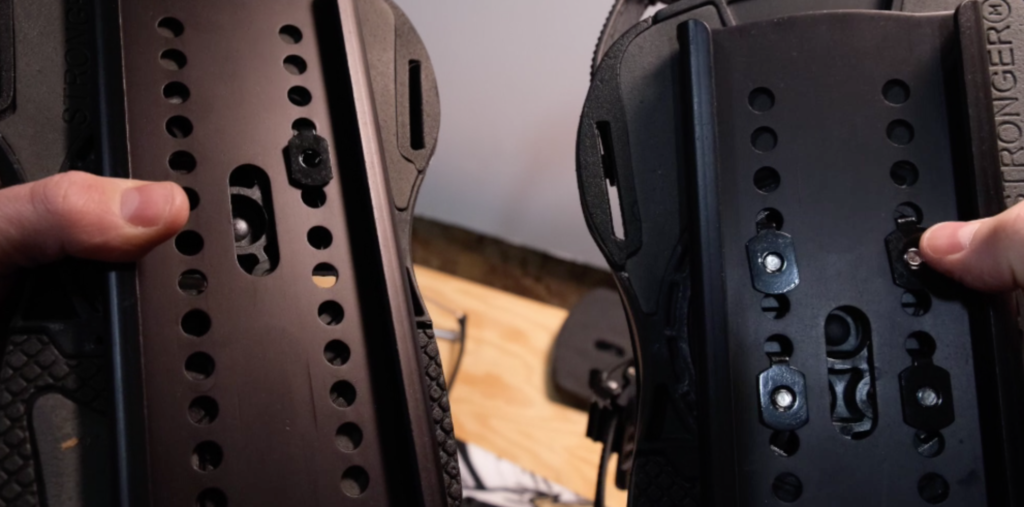
Tighten down your bindings firmly. Repeat this process on the other foot. But this time you can just match the placement of the first foot. You can just count the number of holes from the toe side and transfer that.
You’re just about finished here…
5. Secure the Pivot Bars
In our kit we have these pivot pins that serve 2 purposes. For climbing, they slide through the toe bracket and the toe of your bindings and lock your toes into place. For downhill, they slide through the toe of the rail to lock the rails onto the deck.
Many systems do not make use of these pivot pins.
These pins will have some kind of wire or tail that secures them to your bindings so that they do not get lost during transitions. You want to secure these to the outside of your feet when positioned for downhill so that when their threaded into place, they clip on the inside of your feet. So find a way to mount that wire to the correct side of your bindings by looping it through your straps or any hoes on your bindings.
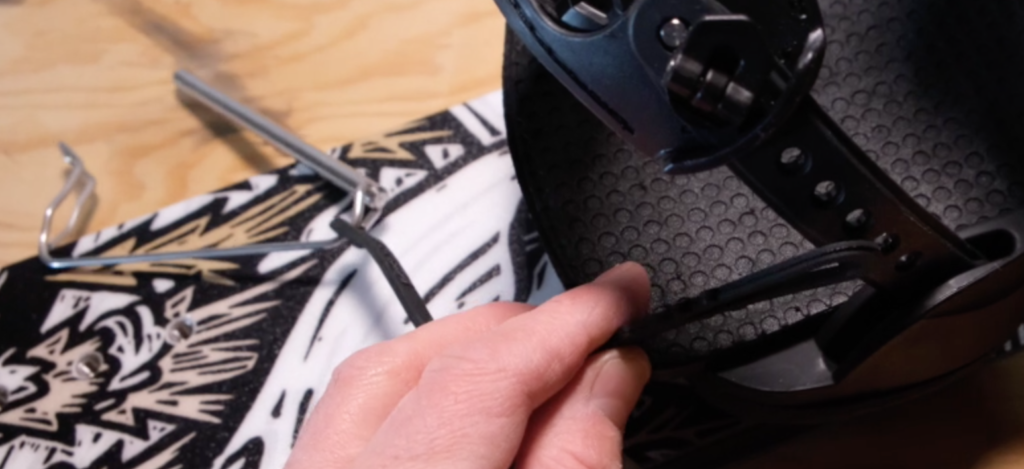
Conclusion
In a lot of cases, you’re just gonna go to your local shop and get your rig setup by the pros. But this process is so easy and if you’re out in the backcountry a thorough understanding of your equipment is crucial. So it’s totally worth it to understand this entire process.
What’s more, this specific process of a splitboard setup with regular bindings is not a bad way to get those first, pristine backcountry tracks in. It can be a little heavier than other setups, but it’s more than enough in terms of kit for your introductory hut trips and resort ascents. In this case, you’re probably ordering the Voilé kit online, so doing the installation yourself is the most convenient approach.
Hope this guide was helpful. I’m still tweaking little elements all the time, so give me a shout if you spot any confusion or you think I can improve something here and please be sure to subscribe to the YouTube channel where I’ll be knocking out gear reviews and tutorials as well as some breakdowns on lines to explore. Most of my riding is in the Denver front range region, so it’ll be particularly helpful if you’re nearby.
I’m also more than happy to help if you need any personalized assistance with your splitboard setup. Reach out at [email protected].

